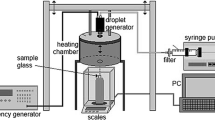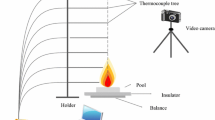Abstract
The results of a numerical and experimental investigation into the evaporation characteristics of the 3-pentanone–isooctane binary system are presented. The behaviour of the system is shown to be nonideal, exhibiting positive deviations from Raoult's law. Thus, the evaporation characteristics of 3-pentanone–isooctane mixtures are shown to be controlled by the relative mole fractions of the two components contained within the liquid phase. The preferential evaporation of 3-pentanone from mixtures containing low concentrations of 3-pentanone is predicted numerically and is confirmed experimentally. The implications of this result with respect to the use of 3-pentanone as a fluorescence marker for isooctane fuel in engine research are discussed at length. The influence high 3-pentanone concentrations on the atomisation behaviour and the optical depth of 3-pentanone–isooctane mixtures is predicted and discussed.






Similar content being viewed by others
Abbreviations
- A :
-
empirical constant
- B :
-
empirical constant
- C :
-
empirical constant
- D :
-
empirical constant
- P :
-
total pressure
- P c :
-
critical pressure
- P i 0 :
-
vapour pressure of component i
- T :
-
absolute temperature
- T c :
-
critical temperature
- x i :
-
liquid-phase mole fraction of component i
- y i :
-
vapour-phase mole fraction of component i
- γ i :
-
activity coefficient of component i
- γ i ∞ :
-
activity coefficient of component i at infinite dilution
- η :
-
liquid viscosity
- θ :
-
1−(T/T c), see Eq. (5)
- ρ :
-
liquid density
- σ :
-
surface tension
- Λ ij :
-
empirical constant
- 1:
-
isooctane
- 2:
-
3-pentanone
References
Arnold A, Becker H, Suntz R, Monkhouse P, Wolfrum J, Maly R, Pfister W (1990) Flame-front imaging in an internal-combustion engine simulator by laser-induced fluorescence of acetaldehyde. Opt Lett 15:831–833
Baritaud T, Heinze T (1992) Gasoline distribution measurements with PLIF in a SI engine. SAE technical paper 922355
Berckmüller M (1996) A study of mixture formation in a lean burn research engine using laser fluorescence imaging. Dissertation, School of Mechanical Engineering, Cranfield University, UK
Berckmüller M, Tait N, Locket R, Greenhalgh D, Ishii K, Urata Y, Umiyama H, Yoshida K (1994) In-cylinder crank-angle-resolved imaging of fuel concentration in a firing spark-ignition engine using planar laser-induced fluorescence. In: Twenty-fifth symposium (international) on combustion. The Combustion Institute, Pittsburgh, pp 151–156
Davy M, Williams P (1999) The effects of flash boiling on mixture formation in a firing direct-injection spark-ignition (DISI) engine. In: Spicher U (ed) Proc of international congress on Direkteinspritzung im Ottomotor II (gasoline direct injection engines). Expert, Renningen-Malmsheim, ISBN 3–8169-1822-0, pp 154–170
Davy M, Williams P, Anderson R (2000) Effects of fuel composition in a firing direct-injection spark-ignition (DISI) engine: an experimental study using Mie scattering and planar laser-induced fluorescence (PLIF) techniques. In: SAE special publication SP-1547. Society of Automotive Engineers, Warrendale, pp 67–82 (also published as SAE technical paper 2000-01-1904)
Einecke S, Schulz C, Sick V (2000) Measurement of temperature, fuel concentration and equivalence ratio fields using tracer LIF in IC engine combustion. Appl Phys B 71:717–723
Ekenberg M, Johansson B (2000) Fuel distribution in an air assist direct injected spark ignition engine with central injection and spark plug measured with laser induced fluorescence. In: SAE special publication SP-1547. Society of Automotive Engineers, Warrendale, pp 1–8 (also published as SAE technical paper 2000-01-1898)
Fuchs R, Krenzer L, Gaube J (1984) Excess properties of binary mixtures composed of a polar component and an alkane. Ber Bunsenges Phys Chem 88:642–649
Ghandhi J, Felton P (1996) On the fluorescent behaviour of ketones at high temperatures. Exp Fluids 21:143–144
Gold M, Stokes J, Morgan R, Heikal M, Begg S, De Sercey G (2001) Air–fuel mixing in a homogeneous charge DI gasoline engine. In: SAE special publication SP-1584. Society of Automotive Engineers, Warrendale, pp 123–131 (also published as SAE technical paper 2001-01-0968)
Grossmann F, Monkhouse P, Ridder M, Sick V, Wolfrum J (1996) Temperature and pressure dependencies of the laser-induced fluorescence of gas-phase acetone and 3-pentanone. Appl Phys B 62:249–253
Han D, Steeper R (2002a) Examination of iso-octane/ketone mixtures for quantitative lif measurements in a DISI engine. In: SAE special publication SP-1693. Society of Automotive Engineers, Warrendale, pp 173–184 (also published as SAE technical paper 2002–01–0837)
Han D, Steeper R (2002b) An LIF equivalence ratio imaging technique for multicomponent fuels in an IC engine. In: Twenty-ninth symposium (international) on combustion. The Combustion Institute, Pittsburgh
Hansen D, Lee E (1975) Radiative and nonradiative transitions in the first excited singlet state of symmetrical methyl-substituted acetones. J Chem Phys 62:183–189
Hertz H, Aldén M (1987) Calibration of imaging laser-induced fluorescence measurements in highly absorbing flames. Appl Phys B 42:97–102
Isdale J, MacGillivray J, Cartwright G (1985) Prediction of viscosity of organic liquid mixtures by a group contribution method. Nat Eng Lab Rept, Glasgow, Scotland
Jasper J (1972) Surface tension of pure liquid compounds. J Phys Chem Ref Data 1:841
Krämer H, Einecke S, Schultz C, Sick V, Nattrass S, Kitching J (1998) Simultaneous mapping of the distribution of different fuel volatility classes using tracer-LIF and NIR-tomography in an IC engine. SAE technical paper 982467
Law C (1982) Recent advances in droplet vaporisation and combustion. Prog Energy Combust Sci 8:171–201
Le Coz J, Baritaud T (1996) Application of laser induced fluorescence for measuring the thickness of evaporating gasoline liquid films. In: Adrian R et al. (eds) Developments in laser techniques and applications to fluid mechanics, proceedings of the seventh international symposium, Lisbon, Portugal, 11–14 July 1994. Springer, Berlin Heidelberg New York, ISBN 3-540-60236-4, pp 115–131
Lefebvre A (1989) Atomization and sprays. Taylor & Francis, Levittown, PA, pp 11–14
Lin MT, Sick V (2002) Mixture evaporative characteristics predictions for LIF measurements using PSRK (predictive Soave–Redlich–Kwong) equation of state. SAE technical paper 2002-01-2750
Neij H, Johansson B, Aldén M (1994) Development and demonstration of 2D-LIF for studies of mixture preparation in SI engines. Combust Flame 99:449–457
Ossler F, Aldén M (1997) Measurements of picosecond laser induced fluorescence from gas-phase 3-pentanone and acetone: Implications to combustion diagnostics. Appl Phys B 64:493–502
Pádua A, Farleira J, Calado J, Wakeham W (1996) Density and viscosity measurements of 2,2,4-trimethylpentane (isooctane) from 198 K to 348 K and up to 100 Mpa. J Chem Eng Data 41:1488–1494
Reid R, Prausnitz J, Poling B (1987) Fluid phase equilibria in multicomponent systems. In: The properties of gases & liquids, 4th edn. McGraw-Hill, New York, pp 241–387
Richter M, Axelsson B, Aldén M, Carlsson LO, Dahlberg M, Nisbet J, Simonsen H (1999) Investigation of the fuel distribution and in-cylinder flow field in a stratified charge engine using laser techniques and comparison with CFD-modelling. SAE technical paper 1999-01-3540
Sandler S (1999) Chemical and engineering thermodynamics, 3rd edn. Wiley, New York
Sick V, Stojkovic B (2001) Attenuation effects on imaging diagnostics of hollow-cone sprays. Appl Opt 40:2435–2442
Skippon S, Norton D (1998) The effects of gasoline volatility on mass and composition of the inlet port wall film in port injected SI engines. SAE technical paper 982517
Steeper R, Stevens E (2000) Characterization of combustion, piston temperature, fuel sprays, and fuel–air mixing in a DISI optical engine. In: SAE special publication SP-1562. Society of Automotive Engineers, Warrendale, pp 235–244 (also published as SAE technical paper 2000-01-2900)
Stojkovic S, Sick V (2001) Evolution and impingement of an automotive fuel spray investigated with simultaneous Mie/LIF techniques. Appl Phys B 73:75–83
Thomas E, Eckert C (1984) Prediction of limiting activity coefficients by a modified separation of cohesive energy density model and UNIFAC. Ind Eng Chem Process Des Dev 23:194–209
Tong K, Quay B, Zello J, Santavicca D (2001) Fuel volatility effects on mixture preparation and performance in a GDI engine during cold start. SAE technical paper 2001-01-3650
Williams P, Beckwith P (1994) Correlation between the liquid fuel properties density, viscosity and surface tension and the drop sizes produced by an SI engine pintle-type port fuel injector. In: SAE special publication SP-1054. Society of Automotive Engineers, Warrendale, pp 41–55 (also published as SAE technical paper 941864)
Wolff D, Beushausen V, Schlüter H, Andresen P, Hentschel W, Manz P, Arndt S (1994) Quantitative 2D-mixture fraction imaging inside an internal combustion engine using acetone-fluorescence. In: Proc international symposium COMODIA 94, Yokohama, pp 445–451
Zuo B, Gomes A, Rutland C (2002) Modeling superheated fuel sprays and vaporization. Int J Eng Res 1:321–336
Author information
Authors and Affiliations
Corresponding author
Rights and permissions
About this article
Cite this article
Davy, M., Williams, P., Han, D. et al. Evaporation characteristics of the 3-pentanone–isooctane binary system. Exp Fluids 35, 92–99 (2003). https://doi.org/10.1007/s00348-003-0639-4
Received:
Accepted:
Published:
Issue Date:
DOI: https://doi.org/10.1007/s00348-003-0639-4




